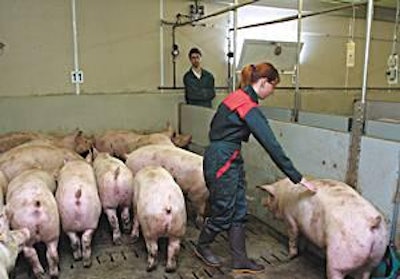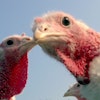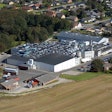
French pig producers could face a big shake-up in the current structure of the industry as farmers meet the challenges of low pig prices, new animal welfare regulations, tough environment laws, high feed prices and declining meat sales.
In the short term, the pig industry’s number one priority is to raise pig prices so they can all afford to convert to group housing for sows to meet the European Union’s 2013 deadline for a curb on the use of gestation stalls.
In September, pig producers claimed they were losing up to 15 Euros on every pig sold and said they did not have enough money to invest in new systems for the future—and are asking the EU to delay the imposition of the rules for another couple of years.
Pig industry under pressure
The president of the pig producers’ organization in Brittany, Michel Bloc’h, told Pig International that his members are concerned that French authorities are applying EU rules too harshly when compared with what is happening in other EU-member states.
“We still remember what happened when the poultry industry had to implement new EU welfare regulations,” says Bloc’h. “French farmers complied at great expense, but the farmers in Spain did not and were granted extra time to meet the deadline and, of course, they benefited from that because they didn’t have all the expense of making changes to their systems.”
However, he maintained that at least 45% of France’s pig farmers would meet the 2013 deadline, while others only needed one or two years extra to convert their systems.
Speaking during the 2011 SPACE livestock show in Rennes, France, Bloc’h said, “Here in Brittany, pig producers are very motivated and we are going to fight to survive. Pig production is like a religion here. The French government must accept that it has to allow pig farmers to expand, even if it has to amend the environmental laws to allow this.
“We also need more research and development to help the pig industry modernize systems and increase production,” he added. “The problem is our industry is often forgotten, compared with other sectors, because we don’t have pretty cows in the fields, for example.”
When asked if any pig producers in Brittany had opted for outdoor pig production in an attempt to win public sympathy, Bloc’h said, “Even that is difficult here, because you have to apply for a special permit to keep pigs outdoors—and it is very difficult to obtain one of those permits.”
Meanwhile, the director of international pig breeding company PIC in France, Lionel Puechberty, warned that consistently high animal feed also is threatening the future of the pig industry in France.
“The situation is very challenging at present in France, with high animal feed prices, as well as new welfare regulations, combined with the fact that the average unit here only has about 200 sows and it is difficult for producers to expand their businesses.”
Collective sow units
Puechberty suggested one possible way forward is a move to collective sow units, which could provide pig farmers with piglets to take from weaning though to finishing, instead of the traditional farrow-to-finish operations.
“I am sure collective sow units would be able to absorb the costs of new welfare regulations and this would allow pig producers to remain small and independent while still producing for the commodity market,” said Puechberty.
He also argued for more focus on the “total economy,” involving the whole supply chain, with pig farmers remaining small, but working more closely together through their cooperative societies (there are currently about 20 across France), which he predicted would become very important for the industry in future.
Michel Rieu, head of the department of economics at the French Institute of Pork, IFIP, is more positive and told Pig International that he believes the 2013 deadline for group sow housing will force French farmers to modernize their farms.
Agreeing that conditions are particularly challenging in France at the moment, Rieu pointed out that this is also true across the rest of Europe, where, he said, even Denmark is facing financial hurdles, and pig producers in the Netherlands, who had expanded at great cost a couple of years ago, were now finding times are tough.
However, he did agree that the French model of farrow-to-finish could be adapted with collective sow units to take advantage of the economy and refocus the small family unit, which, he commented, could have an opportunity to expand from an average 200 sows each to between 300 and 400 sows.
“We need the average size of the French farms to increase with more technical input. We need a vision and strategy for the future and we are working on that now – an action plan to modernize the French pig industry and the whole meat sector,” Rieu said.
Focusing on niche, export markets
Rieu pointed out that low pork product prices are not always good for the industry, as people often turn up their noses at food that is cheaper than other products, because they think low prices mean low quality.
“We also need to work on the image of the product and look more closely at niche market opportunities – and the IFIP is working on all this at the moment.”
This is where niche markets for high-quality products could help the pig industry in France. In addition, Rieu said that French pig farmers should also look to get more value out of their exports – the country exports pig meat to several other EU countries, as well as third countries, such as Russia and Japan.
“Adding just a few cents to each kilogram could make a huge difference to the profitability of the pork industry in France,” he said. “We need more focus on these products and we need to analyze the markets carefully to see how we can do this and how we can restore our industry so it occupies its former prominent position in pig production in Europe.”
Future challenges
The IFIP identified the pig industry’s three major future challenges as managing pig welfare, controlling environmental impacts and developing activity in the international arena. It is also keen to promote innovation, by developing new self-diagnosis tools and decision-making aids for pig producers and broadening the range of products that are produced.
Bernard Mahé, director of Sanders, the feed branch of Groupe Glon, agreed that French pig producers need to focus more on the export market and be more ambitious and determined to win, he commented.
“Farmers here are good at producing pigs, but they need to work more closely with the abattoirs and markets to develop a market for tomorrow,” said Mahé. “We slaughter about 25 million pigs a year, down from 28 million a few years ago. I think French pig producers should be looking at developing a new business structure where farmers can manage the process from production through to the markets by getting much closer to the supply chain.”


















